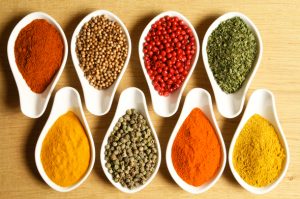Mama’s Punjabi Recipes: Khanne de Baytreen Rang (The Colors of Good Eating)
Saved under Community, Current Stories, Recipe Corner
Tags: Baytown, Clear Lake, Cypress, Desi news, Greater Houston, Houston, Houston Desi news, India, Indian American community, Indian News, Indians in America, Indo-American News, Katy, Mama's Punjabi Recepie, NRI, pearland, south asia, South India, Sugar Land, Texas, USA
Cooking delicious food requires an interest in improving your skills and the desire to eat well, regardless of the type of cuisine you like. But, if you enjoy Indian cooking, then it helps to understand the traditions that are behind the food you will make and serve.
Perhaps no other cuisine is steeped in appreciation of the history, religion and culture as all the types of food available across the Indian subcontinent. And this includes understanding the reasons for the vast amount of vegetarianism in the country. This is rooted in Hindu, Buddhist and Jain religious practices that stretch back thousands of years to the Rigveda. Many of the ingredients have added significance, like yogurt which is associated with the baby Krishna and milk which is used in religious purification practices.
Ancient Hindu texts do not explicitly prohibit eating meat, but they advocate ahimsa – non-violence against all forms of life including animals. Through the centuries, ahimsa has been ingrained in every form of daily life and it has led to the development of a lacto-vegetarian lifestyle and methods of growing food that are in sync with nature. With the ancient understanding of the power, aroma and flavors of spices, the variety and refinement of Indian vegetarian cuisine has achieved an elevated status not found in other cuisines.
Though not related to cooking, I believe that it is important to start the morning with a refreshing bath to cleanse the body and then take the time to softly recite the gayathri mantra and other prayers to yourself to cleanse your mind and keep it calm.
It is important to remember that vegetables, fruits and spices have both nutritious as well as healing qualities and for me these can be summed up by either heating or cooling properties. If you are attuned to your body, you can understand how it will react to the use of these items and whether they will be beneficial for you.
When I was a young girl growing up in my ancestral homes in Lyallpur-Jhang-Maghiana (in what has now become Pakistan), I learnt the values of foods and when to eat them. For example, whole massar daal (flat brown kernel lentils) is not only quick to make, but has higher calories and protein than other daals and so is eaten mostly in the winter months to keep a person warm. In the hot summer months, when the farm workers needed to cool off, they would drink kanji (a beetroot drink) or dahin di lassi (a yogurt drink) to hydrate and get refreshed.
There are many spices that act of the body likewise, and it is important to know there significance as well as medicinal values, which have only recently been acknowledged through western scientific methods. For example, haldi (turmeric) has long been as a local antiseptic and antibiotic and now has been found to have antioxidant properties too.
A little haldi thrown into a teaspoon of warm mustard seed oil can be used to dab skin puncture woods. Fennel seeds are routinely eaten after meals to take mouth odors away, freshen the breath and aid in digestion. Ajwain (carom seeds) is considered hot and when swallowed with a pinch of salt can help an upset stomach.
Here is a partial list of foods, spices and items that are hot or cold and are used by those who understand their properties to keep healthy.
Hot foods:
1. Herbs & Spices: Methi seeds, ajawain, adrak, cinnamon twig, clove, garlic, nutmeg, pepper, coriander, spearmint, sweet basil, cardamom
2. Vegetables: Chives, leeks, mustard greens, onions, pumpkin, spring onions, squash, karela (bitter gourd)
3. Fruits: Cherry, coconut, guava, peach, raspberry, apricot, blackberry, black currant, mangoes, peaches, mandarin orange, grape
4. Sugars: Honey, gur (jaggery), brown sugar
Cold Foods:
1. Herbs & Spices: Haldi (turmeric), pudina (mint), aamla (gooseberry), hing (asafoetida)
2. Vegetables: Alfalfa sprouts, asparagus, khira (cucumber), baingan (eggplant), lettuce, (bhaen) lotus root, khumb (mushroom), spinach, tomato, broccoli, cauliflower, zuccini, corn, padval (snake gourd).
3. Fruits: Banana, grapefruit, persimmon, sugar cane, watermelon, strawberry, tangerine, tomato, pineapple
MAMA’S TIP OF THE WEEK
HOW TO EXTEND THE LIFE OF FRESH GINGER
In Indian cuisine, ginger or adrak is one of the most frequently used herbs, either fresh or in powder form, and it contributes not only to the aroma and taste but also the proper digestion of the food. Fresh ginger is sold in heaps at the stores and is often peeled and turned into a pickle by itself or with green chillies and lemon.
If you have fresh ginger and it looks like it make start to wilt, here’s a simple way to extend its life. Peel the ginger, then chop it into small pieces. Now heat up a small pan and stir fry the ginger till it is only slightly brown. Take off the heat and scoop into a plate to cool off. Once cool, put the ginger in a small container, close the lid and place in the fridge. You can reuse the ginger now for several more weeks.

Shakuntla Malhotra is a skilled cook of Punjabi dishes made in the old-fashioned style that she learnt as a young woman in her ancestral home in Lyallpur (since renamed Faisalabad), India before it became part of Pakistan after the Partition in 1947. People have often admired her cooking for its simplicity and taste that comes with each mouthful. Even in her mid-eighties, she continues to cook daily and agreed to share some of her delectable Punjabi recipes

